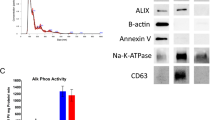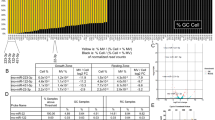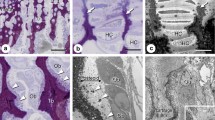Abstract
Matrix vesicles are extracellular organelles produced by cells that mineralize their matrix. They contain enzymes that are associated with calcification and are regulated by vitamin D metabolites in a cell maturation-dependent manner. Matrix vesicles also contain metalloproteinases that degrade proteoglycans, macromolecules known to inhibit calcificationin vitro, as well as plasminogen activator, a proteinase postulated to play a role in activation of latent TGF-\. In the present study, we examined whether matrix vesicle metalloproteinase and plasminogen activator are regulated by 1,25(OH)2D3 and 24,25 (OH)2D3. Matrix vesicles and plasma membranes were isolated from fourth passage cultures of resting zone chondrocytes that had been incubated with 1010-10-7 M24,25(OH)2D3 or growth zone chondrocytes incubated with 10-11-l0-8 M 1,25(OH)2D3, and their alkaline phosphatase, active and total neutral metalloproteinase, and plasminogen activator activities determined. 24,25(OH)2D3 increased alkaline phosphatase by 35–60%, decreased active and total metalloproteinase by 75%, and increased plasminogen activator by fivefold in matrix vesicles from resting zone chondrocyte cultures. No effect of vitamin D treatment was observed in plasma membranes isolated from these cultures. In contrast, 1,25(OH)2D3 increased alkaline phosphatase by 35–60%, but increased active and total metalloproteinase three- to fivefold and decreased plasminogen activator by as much as 75% in matrix vesicles isolated from growth zone chondrocyte cultures. Vitamin D treatment had no effect on plasma membrane alkaline phosphatase or metalloproteinase, but decreased plasminogen activator activity. The results demonstrate that neutral metalloproteinase and plasminogen activator activity in matrix vesicles are regulated by vitamin D metabolites in a cell maturation-specific manner. In addition, they support the hypothesis that 1,25(OH)2D3 regulation of matrix vesicle function facilitates calcification by increasing alkaline phosphatase and phospholipase A2 specific activities as well as metalloprotemases which degrade proteoglycans.
Similar content being viewed by others
References
Anderson HC (1969) Vesicles associated with calcification in the matrix of epiphyseal cartilage. J Cell Biol 41:59–72
Bonucci E (1970) Fine structure and histochemistry of “calcifying globules” in epiphyseal cartilage. Z Zellforsch Mikrosk Anat 103:192–217
Bernard GW (1972) Ultrastructural observations of initial calcification in dentine and enamel. J Ultrastruct Res 41:1–17
Ali SY, Sajdera SW, Anderson HC (1970) Isolation and characterization of calcifying matrix vesicles from epiphyseal cartilage. Proc Natl Acad Sci 67:1513–1520
Brighton CT, Hunt RM (1974) Mitochondrial calcium and its role in calcification. Histochemical localization of calcium in electron micrographs of the epiphyseal growth plate with K-pyroantimonate. Clin Orthop 100:406–416
Anderson HC (1985) Matrix vesicle calcification: review and update. In: Peck WA (ed) Bone and mineral research, vol 3. Excerpta Medica, Amsterdam, pp 109–149
Boskey AL, Posner AS (1976) Extraction of a calciumphospholipid-phosphate complex from bone. Calcif Tissue Int 19:273–283
Wuthier RE, Gore ST (1977) Partition of inorganic ions and phospholipids in isolated cell, membrane and matrix vesicle fractions: evidence for Ca-Piacidic phospholipid complexes. Calcif Tissue Int 24:163–171
Gay CF, Schraev H, Hargest TE (1978) Ultrastructure of matrix vesicles and mineral in unfixed embryonic bone. Metab Bone Dis Rel Res 1:105–108
Raggio CL, Boyan BD, Boskey AL (1986) In vivo hydroxyapatite formation induced by lipids. J Bone Miner Res 1(5): 409–415
Wuthier RE (1973) The role of phospholipids in biological calcifications: distribution of phospholipase activity in calcifying epiphyseal cartilage. Clin Orthop Rel Res 90:191–200
Watkins EL, Stilo JV, Wuthier RE (1980) Subcellular fractionation of epiphyseal cartilage. Isolation of matrix vesicles and profiles of enzymes, phospholipids, calcium, and phosphate. Biochim Biophys Acta 631:289–304
Felix R, Fleisch H (1976) Pyrophosphatase and ATPase of isolated cartilage matrix vesicles. Calcif Tissue Res 22:1–5
Einhorn TA, Hirschman A, Gordon SL, Avitable MJ, Carty RP (1986) Enzymes associated with matrix vesicles isolated from osteoarthritic cartilage. In: Ali SY (ed) Cell mediated calcification and matrix vesicles. Elsevier Science Publishers, New York, pp 359–364
Boyan BD, Schwartz Z, Carnes D, Ramirez V (1988) The effects of vitamin D metabolites on the plasma and matrix vesicle membranes of growth and resting cartilage in vitro. Endocrinology 122:2851–2860
Schwartz Z, Boyan BD (1988) The effects of vitamin D and metabolites on phospholipase A2 activity of growth zone and resting zone cartilage cells in vitro. Endocrinology 122:2191–2198
Schwartz Z, Knight G, Swain L, Boyan BD (1988) Localization of vitamin D-responsive alkaline phosphatase in cultured chondrocytes. J Biol Chem 263:6023–6026
Boyan BD, Schwartz Z, Bonewald LF, Swain LD (1989) Localization of 1,25-(OH)2D3-responsive alkaline phosphatase in osteoblast-like cells (ROS 17/2.8, MG-63, and MC 3T3) and growth cartilage cells in culture. J Biol Chem 264:11879–11886
Schwartz Z, Dennis R, Bonewald L, Swain L, Gomez R, Boyan BD (1992) Differential regulation of prostaglandin E2 synthesis and phospholipase A2 activity by 1,25-(OH)2D3D3 in three osteoblast-like cell lines (MC-3T3-E1, ROS 17/2.8 and MG-63). Bone 13:51–58
Schwartz Z, Schlader DL, Swain LD, Boyan BD (1988) Direct effects of 1,25-dihydroxyvitamin D3 and 24,25-dihydroxyvitamin D3 on growth zone and resting zone chondrocyte membrane alkaline phosphatase and phospholipase A2 specific activities. Endocrinology 123:2878–2884
Boyan BD, Dean DD, Sylvia VL, Schwartz Z (1994) Nongenomic regulation of extracellular matrix events by vitamin D metabolites. J Cell Biochem 56:331–339
Chen C-C, Boskey AL (1985) Mechanisms of proteoglycan inhibition of hydroxyapatite growth. Calcif Tissue Int 37:395–400
Dziewiatkowski DD, Majznerski LL (1985) Role of proteoglycans in endochondral ossification: inhibition of calcification. Calcif Tissue Int 37:560–564
Kawabe N, Ehrlich MG, Mankin HJ (1986) In vivo degradation systems of the epiphyseal cartilage. Clin Orthop 211:244–251
Poole AR, Pidoux I, Rosenberg L (1982) Role of proteoglycans in endochondral ossification: immunofluorescent localization of link protein and proteoglycan monomer in bovine fetal epiphyseal growth plate. J Cell Biol 92:249–260
Poole AR, Matsui Y, Hinek A, Lee ER (1989) Cartilage macromolecules and the calcification of cartilage matrix. Anat Rec 224(2): 167–179
Buckwalter JA, Ehrlich MG, Armstrong AL, Mankin HJ (1987) Electron microscopic analysis of articular cartilage proteoglycan degradation by growth plate enzymes. J Orthop Res 5:128–132
Takagi M, Parmley RT, Denys FR (1981) Endocytic activity and ultrastructural cytochemistry of lysosome-related organelles in epiphyseal chondrocytes. J Ultrastruct Res 74:69–82
Boskey AL, Boyan BD, Doty SB, Feliciano A, Greer K, Weiland D, Swain LD, Schwartz Z (1992) Studies of matrix vesicle-induced mineralization in a gelatin gel. Bone Miner 17:257–262
Hirschman A, Deutsch D, Hirschman M, Bab I, Sela J, Muhlrad A (1983) Neutral peptidase activities in matrix vesicles from bovine fetal alveolar bone and dog osteosarcoma. Calcif Tissue Int 35:791–797
Katsura N, Yamada K (1986) Isolation and characterization of a metalloprotease associated with chicken epiphyseal cartilage matrix vesicles. Bone 7:137–143
Einhorn TA, Hirschman A, Kaplan C, Nashed R, Devlin VJ, Warman J (1989) Neutral protein-degrading enzymes in experimental fracture callus: a preliminary report. J Orthop Res 7:792–805
Dean DD, Schwartz Z, Muniz OE, Gomez R, Swain LD, Howell DS, Boyan BD (1992) Matrix vesicles are enriched in metalloproteinases that degrade proteoglycans. Calcif Tissue Int 50:342–349
Dean DD, Schwartz Z, Bonewald L, Muniz OE, Morales S, Gomez R, Brooks BP, Qiao M, Howell DS, Boyan BD (1994) Matrix vesicles produced by osteoblast-like cells in culture become significantly enriched in proteoglycan-degrading metalloproteinases after addition of \-glycerophosphate and ascorbic acid. Calcif Tissue Int 54:399–408
Boyan BD, Schwartz Z, Park-Snyder S, Dean DD, Yang F, Twardzik D, Bonewald LF (1994) Latent transforming growth factor \ is produced by chondrocytes and activated by extracellular matrix vesicles upon exposure to 1,25-(OH)2D3. J Biol Chem 269:28374–28381
Boyan BD, Schwartz Z, Swain LD, Carnes Jr DL, Zislis T (1988) Differential expression of phenotype by resting zone and growth region costochondral chondrocytes in vitro. Bone 9:185–194
Schwartz Z, Schlader D, Ramirez V, Kennedy MB, Boyan BD (1989) Effects of vitamin D3 metabolites on collagen production and cell proliferation of growth zone and resting zone cartilage cells in vitro. J Bone Miner Res 4:199–207
Schwartz Z, Swain LD, Ramirez B, Boyan BD (1990) Regulation of arachidonic acid turnover by 1,25-(OH)2D3 and 24,25-(OH)2D3 in growth zone and resting zone chondrocyte cultures. Biochim Biophys Acta 1027:278–286
Schwartz Z, Langsten GG, Swain LD, Boyan BD (1991) Inhibition of l,25-(OH)2D3-and 24,25-(OH)2D3-dependent stimulation of alkaline phosphatase activity by A23187 suggests a role for calcium in the mechanism of vitamin D regulation of chondrocyte cultures. J Bone Miner Res 6:709–718
Schwartz Z, Brooks B, Swain L, Del Toro F, Norman A, Boyan BD (1992) Production of 1,25-(OH)2D3 and 24,25-(OH)2D3 by growth zone and resting zone chondrocytes is dependent on cell maturation and regulated by hormones and growth factors. Endocrinology 130:2495–2504
Schwartz Z, Swain LD, Kelly DW, Brooks B, Boyan BD (1992) Regulation of prostaglandin E2 production by vitamin D metabolites in growth zone and resting zone chondrocyte cultures is dependent on cell maturation. Bone 13:395–401
Schwartz Z, Bonewald LF, Caulfield K, Brooks B, Boyan BD (1993) Direct effects of transforming growth factor-\ on chondrocytes are modulated by vitamin D metabolites in a cell maturation specific manner. Endocrinology 132:1544–1552
Schwartz Z, Dean DD, Walton JK, Brooks BP, Boyan BD (1995) Treatment of resting zone chondrocytes with 24,25-(OH)2D3 induces differentiation into a 1,25-(OH)2D3-responsive phenotype characteristic of growth zone chondrocytes. Endocrinology 136:402–411
Fitzpatrick DF, Davenport GR, Forte L, Landon E (1969) Characterization of plasma membrane proteins in mammalian kidney. I. Preparation of a membrane fraction and separation of the protein. J Biol Chem 244:3561–3569
Lowry OH, Rosebrough ND, Farr AL, Rano RI (1951) Protein measurement with the Folin Phenol reagent. J Biol Chem 193:265–275
Bretaudiere JP, Spillman T (1984) Alkaline phosphatases. In: Bergmeyer HU (ed) Methods of enzymatic analysis, vol 4. Verlag Chemica, Weinheim, Germany, pp 75–92
Ali SY (1976) Analysis of matrix vesicles and their role in the calcification of epiphyseal cartilage. Fed Proc Am Soc Exp Biol 35:135–142
Coleman PL, Green GDJ (1981) A coupled photometric assay for plasminogen activator. In: Lorand L (ed) Methods in enzymology, vol 80. Academic Press, New York, pp 408–414
Sylvia VL, Schwartz Z, Schuman L, Morgan RT, Mackey S, Gomez R, Boyan BD (1993) Maturation-dependent regulation of protein kinase C activity by vitamin D3 metabolites in chondrocyte cultures. J Cell Physiol 157:271–278
Boskey AL, Weintraub S (1986) The effect of vitamin D deficiency on rat bone lipid composition. Bone 7:277–281
Dean DD, Schmitz JP, Lu Y, Schwartz Z, Boyan BD (1995) Chondrocytes produce active metalloproteinases localized in matrix vesicles (abstract). J Dent Res 74(suppl 1):154
Schmitz JP, Dean DD, Schwartz Z, Cochran DL, Grant GM, Klebe RJ, Nakaya H, Boyan BD (1996) Chondrocyte cultures express matrix metalloproteinase mRNA and immunoreative protein: stromelysin-1 and 72 kDa gelatinase are localized in extracellular matrix vesicles. J Cell Biochem 61:375–391
Author information
Authors and Affiliations
Rights and permissions
About this article
Cite this article
Dean, D.D., Boyan, B.D., Muniz, O.E. et al. Vitamin D Metabolites Regulate Matrix Vesicle Metalloproteinase Content in a Cell Maturation-Dependent Manner. Calcif Tissue Int 59, 109–116 (1996). https://doi.org/10.1007/s002239900096
Received:
Accepted:
Issue Date:
DOI: https://doi.org/10.1007/s002239900096




